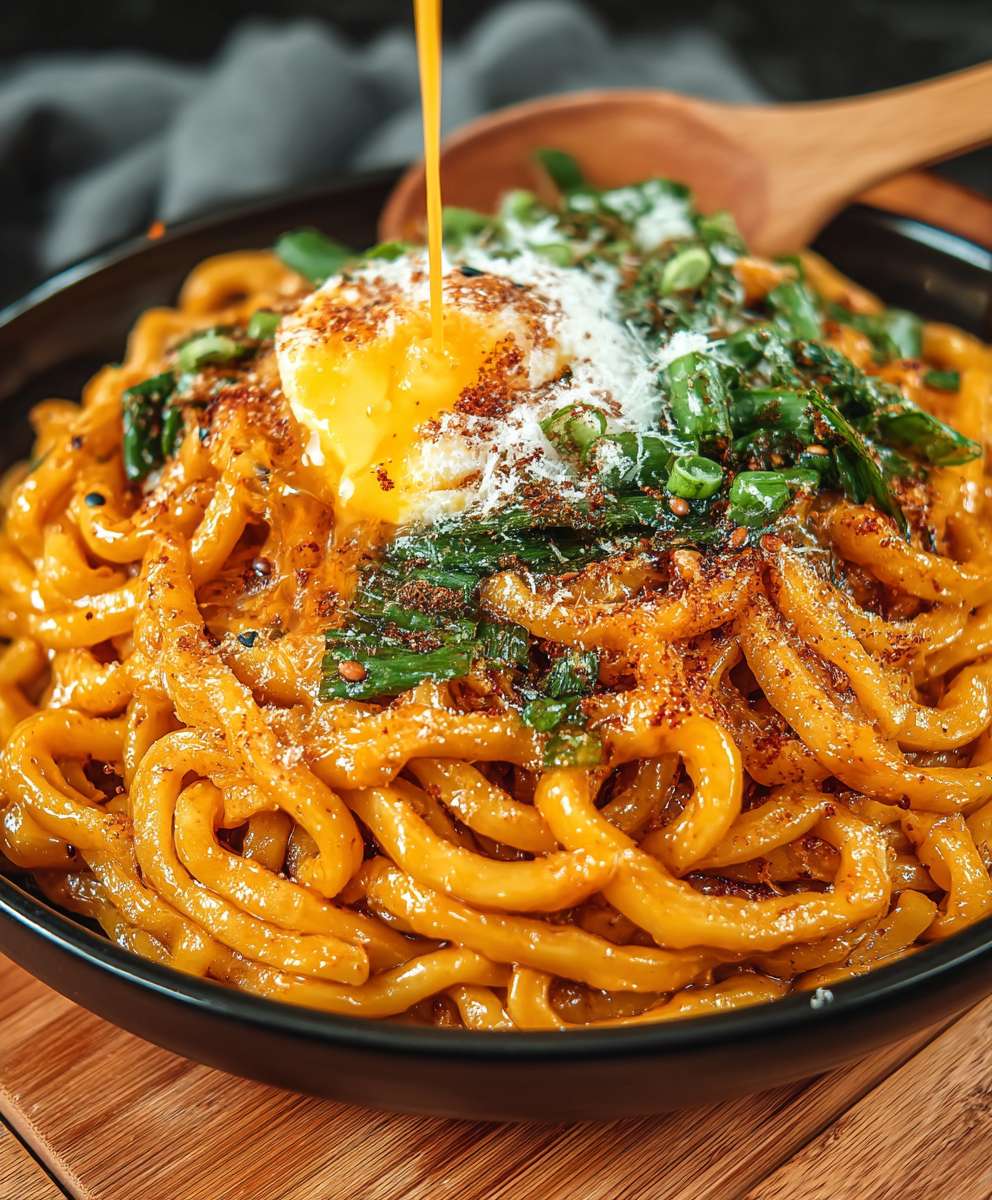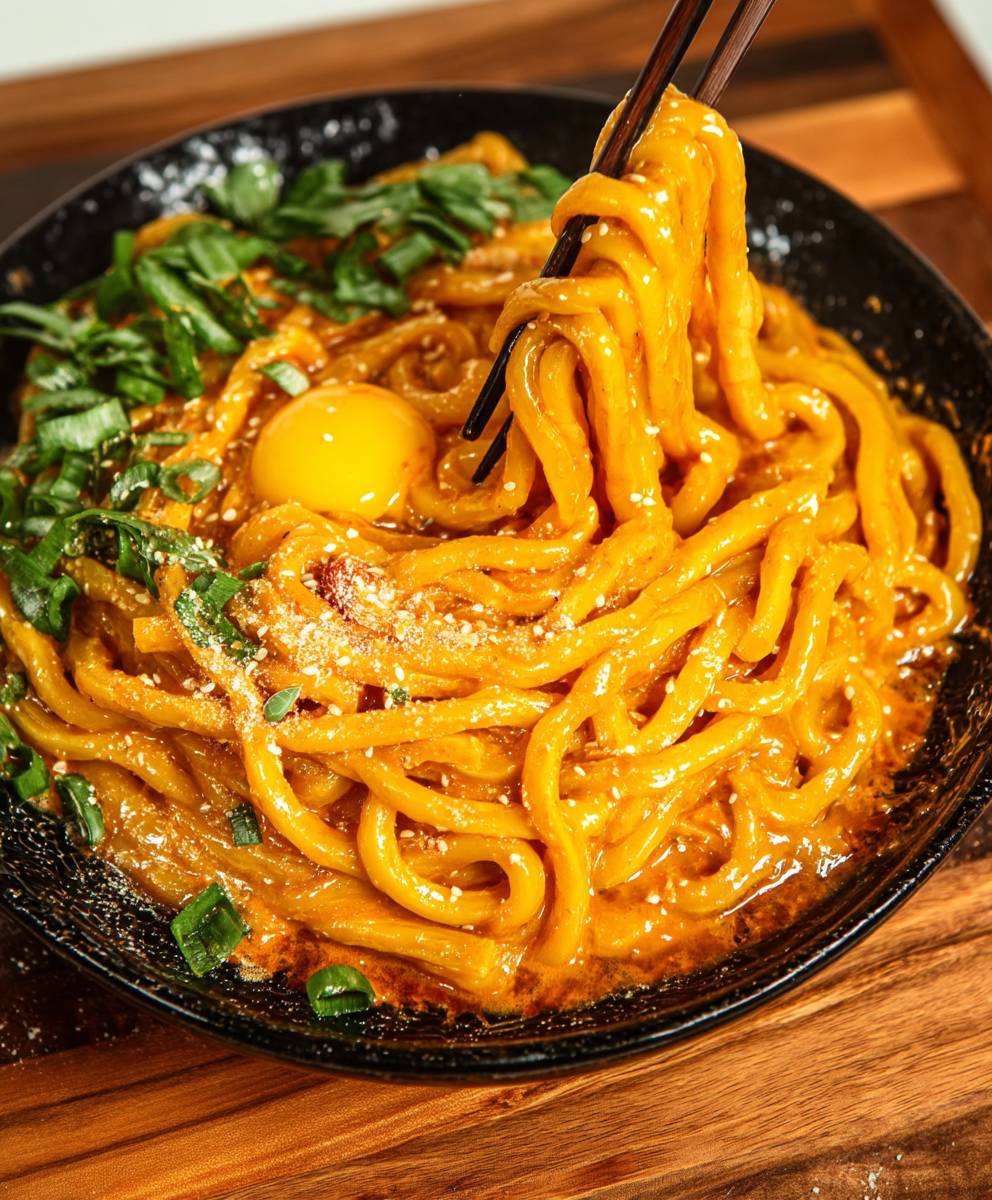Creamy Gochujang Udon Noodles: Prepare to embark on a culinary adventure that will tantalize your taste buds and leave you craving more! Imagine thick, chewy udon noodles, slicked in a vibrant, fiery-red sauce that’s both sweet and savory, with a creamy richness that perfectly balances the spice. This isn’t just a meal; it’s an experience.
Gochujang, the star of this dish, is a fermented Korean chili paste that has been a staple in Korean cuisine for centuries. Its complex flavor profile, developed through a natural fermentation process, adds depth and umami that elevates any dish it graces. While traditionally used in Korean stews and marinades, its versatility shines in this modern fusion creation.
What makes Creamy Gochujang Udon Noodles so irresistible? It’s the perfect marriage of textures and flavors. The chewy udon provides a satisfying bite, while the creamy gochujang sauce delivers a symphony of sweet, spicy, and savory notes. It’s also incredibly quick and easy to make, making it a perfect weeknight meal for busy individuals who don’t want to compromise on flavor. Whether you’re a seasoned spice enthusiast or just looking to add some excitement to your dinner routine, this recipe is guaranteed to become a new favorite.
Ingredients:
- 1 pound Udon noodles (fresh or frozen)
- 2 tablespoons olive oil
- 1 medium yellow onion, thinly sliced
- 2 cloves garlic, minced
- 1 inch ginger, grated
- 1 red bell pepper, thinly sliced
- 8 ounces mushrooms, sliced (cremini, shiitake, or a mix)
- 1/2 cup vegetable broth
- 1/4 cup Gochujang (Korean chili paste)
- 2 tablespoons soy sauce
- 1 tablespoon maple syrup (or honey)
- 1 tablespoon rice vinegar
- 1 teaspoon sesame oil
- 1/4 cup heavy cream (or coconut cream for vegan option)
- 2 green onions, thinly sliced, for garnish
- Sesame seeds, for garnish
- Optional: Protein of your choice (tofu, chicken, shrimp, etc.)
Preparing the Sauce:
- In a medium bowl, whisk together the vegetable broth, Gochujang, soy sauce, maple syrup, rice vinegar, and sesame oil. Make sure the Gochujang is fully dissolved to create a smooth and creamy sauce. Taste and adjust the seasoning as needed. If you prefer a sweeter sauce, add a little more maple syrup. For a spicier kick, add a pinch of red pepper flakes. Set aside.
Cooking the Vegetables and Protein (if using):
- Heat the olive oil in a large skillet or wok over medium-high heat. If you’re adding protein, now’s the time to cook it. For tofu, press out any excess water and cube it. Sauté until golden brown and crispy. For chicken or shrimp, cook until fully cooked through. Remove the protein from the skillet and set aside.
- Add the sliced onion to the skillet and sauté for about 5-7 minutes, or until softened and slightly caramelized. This step is important for developing a deep, savory flavor. Don’t rush it!
- Add the minced garlic and grated ginger to the skillet and sauté for another minute, until fragrant. Be careful not to burn the garlic, as it can become bitter.
- Add the sliced red bell pepper and mushrooms to the skillet. Sauté for about 5-7 minutes, or until the bell pepper is tender-crisp and the mushrooms have released their moisture and are starting to brown.
- If you cooked protein earlier, add it back to the skillet with the vegetables.
Cooking the Udon Noodles:
- While the vegetables are cooking, prepare the udon noodles according to the package directions. Fresh udon noodles usually require just a few minutes of cooking in boiling water, while frozen udon noodles may need a bit longer. Be careful not to overcook the noodles, as they can become mushy.
- Once the udon noodles are cooked, drain them well.
Combining and Finishing the Dish:
- Pour the prepared Gochujang sauce over the vegetables and protein in the skillet. Bring the sauce to a simmer and cook for about 2-3 minutes, allowing it to thicken slightly.
- Stir in the heavy cream (or coconut cream) to create a creamy and luscious sauce. This adds richness and helps to balance the spiciness of the Gochujang.
- Add the drained udon noodles to the skillet and toss everything together until the noodles are evenly coated in the sauce. Make sure every strand of noodle is glistening with that delicious Gochujang goodness!
- Cook for another minute or two, allowing the noodles to absorb some of the sauce and heat through.
Serving and Garnishing:
- Divide the creamy Gochujang udon noodles among bowls.
- Garnish with sliced green onions and sesame seeds.
- Serve immediately and enjoy!
Tips and Variations:
- Spice Level: Adjust the amount of Gochujang to your liking. If you’re sensitive to spice, start with a smaller amount and add more as needed.
- Protein Options: Feel free to use any protein you prefer. Chicken, shrimp, tofu, or even beef would all be delicious in this dish.
- Vegetable Variations: Get creative with your vegetables! Broccoli, carrots, spinach, or bok choy would all be great additions.
- Vegan Option: To make this dish vegan, use coconut cream instead of heavy cream and ensure your Gochujang is vegan-friendly (some brands may contain fish sauce).
- Make Ahead: You can prepare the sauce ahead of time and store it in the refrigerator for up to 3 days. Simply reheat it before adding it to the vegetables and noodles.
- Leftovers: Leftovers can be stored in the refrigerator for up to 2 days. Reheat gently in a skillet or microwave. The noodles may absorb some of the sauce, so you may need to add a splash of water or broth when reheating.
- Adding an Egg: For an extra layer of richness, top each bowl of noodles with a fried egg. The runny yolk will create an even creamier sauce.
- Cheese: A sprinkle of parmesan cheese can add a salty, umami flavor.
Detailed Ingredient Notes:
- Udon Noodles: I prefer using fresh or frozen udon noodles for their chewy texture, but dried udon noodles will also work. Just be sure to cook them according to the package directions. Look for thick, round udon noodles for the best experience.
- Gochujang: Gochujang is a fermented Korean chili paste that is the star of this dish. It has a complex flavor that is spicy, savory, and slightly sweet. You can find it in most Asian grocery stores or online. Different brands of Gochujang can vary in spice level, so start with a smaller amount and adjust to your preference.
- Soy Sauce: I recommend using low-sodium soy sauce to control the saltiness of the dish. You can also use tamari for a gluten-free option.
- Maple Syrup: Maple syrup adds a touch of sweetness to balance the spiciness of the Gochujang. You can substitute honey or agave nectar if you prefer. Brown sugar can also be used in a pinch, but it will add a slightly different flavor.
- Rice Vinegar: Rice vinegar adds a tangy flavor that complements the other ingredients. You can substitute apple cider vinegar or white vinegar if you don’t have rice vinegar on hand, but the flavor will be slightly different.
- Sesame Oil: Sesame oil adds a nutty aroma and flavor to the dish. A little goes a long way, so use it sparingly.
- Heavy Cream: Heavy cream adds richness and creaminess to the sauce. You can substitute coconut cream for a vegan option. Full-fat coconut milk can also be used, but it may not be as thick.
- Vegetable Broth: Vegetable broth provides a base for the sauce. You can substitute chicken broth or beef broth if you prefer, but the flavor will be different.
- Mushrooms: I like to use a mix of cremini and shiitake mushrooms for their earthy flavor, but you can use any type of mushroom you like.
- Red Bell Pepper: Red bell pepper adds sweetness and color to the dish. You can substitute other colors of bell pepper if you prefer.
- Ginger: Fresh ginger adds a warm, spicy flavor to the dish. Use a microplane or grater to finely grate the ginger.
- Garlic: Fresh garlic adds a pungent flavor to the dish. Mince the garlic finely for the best flavor.
- Green Onions: Green onions add a fresh, mild onion flavor to the dish. Slice them thinly for garnish.
- Sesame Seeds: Sesame seeds add a nutty flavor and a crunchy texture to the dish. Toast them lightly in a dry skillet for even more flavor.
Troubleshooting:
- Sauce is too thick: If the sauce becomes too thick, add a little more vegetable broth or water to thin it out.
- Sauce is too thin: If the sauce is too thin, simmer it for a few more minutes to allow it to thicken. You can also add a cornstarch slurry (1 tablespoon cornstarch mixed with 2 tablespoons cold water) to thicken the sauce quickly.
- Noodles are sticking together: To prevent the noodles from sticking together, toss them with a little oil after draining.
- Dish is too spicy: If the dish is too spicy, add a little more maple syrup or cream to balance the heat.
- Dish is too bland: If the dish is too bland, add a

Conclusion:
And there you have it! These Creamy Gochujang Udon Noodles are so much more than just a quick weeknight meal; they’re a flavor explosion waiting to happen. I truly believe this recipe is a must-try for anyone looking to add a little excitement and a whole lot of deliciousness to their dinner routine. The creamy sauce, the chewy udon, and that signature Gochujang kick – it’s a symphony of textures and tastes that will leave you craving more.
But why is this recipe so special? It’s the perfect balance of comfort food and adventurous flavors. It’s incredibly easy to make, even on the busiest of evenings, and it’s endlessly customizable to suit your preferences. Plus, let’s be honest, who can resist a bowl of creamy, spicy noodles?
Now, let’s talk serving suggestions and variations! While these noodles are fantastic on their own, they’re also a great base for adding extra protein and veggies. Consider topping them with grilled chicken or shrimp for a heartier meal. Tofu or tempeh would also be fantastic vegetarian options. For extra crunch, sprinkle some toasted sesame seeds or chopped peanuts on top. And if you’re feeling adventurous, try adding a fried egg for a truly decadent experience.
Don’t be afraid to experiment with the level of spice! If you’re sensitive to heat, start with a smaller amount of Gochujang and add more to taste. You can also tame the spice by adding a dollop of sour cream or Greek yogurt. On the other hand, if you’re a spice lover like me, feel free to crank up the heat with an extra spoonful of Gochujang or a pinch of red pepper flakes.
Serving Suggestions:
- Top with grilled chicken, shrimp, tofu, or tempeh.
- Add a fried egg for extra richness.
- Garnish with toasted sesame seeds, chopped peanuts, or green onions.
- Serve with a side of kimchi or pickled vegetables for a complete meal.
Variations:
- Adjust the amount of Gochujang to your spice preference.
- Add other vegetables like bell peppers, mushrooms, or spinach.
- Use different types of noodles, such as ramen or soba.
- Substitute the cream with coconut milk for a vegan option.
I’m so excited for you to try this recipe and experience the magic of Creamy Gochujang Udon Noodles for yourself. It’s a dish that’s sure to become a new favorite in your household. I’ve poured my heart into creating this recipe, and I truly believe it’s something special.
So, what are you waiting for? Head to the kitchen, gather your ingredients, and get ready to whip up a batch of these incredibly delicious noodles. And most importantly, don’t forget to have fun! Cooking should be an enjoyable experience, so relax, experiment, and let your creativity shine.
Once you’ve tried this recipe, I would absolutely love to hear about your experience! Share your photos and comments on social media using [Your Hashtag Here] or leave a review below. Let me know what variations you tried, what you loved, and what you would change. Your feedback is invaluable and helps me continue to create recipes that you’ll love. I can’t wait to see your culinary creations! Happy cooking!
Creamy Gochujang Udon Noodles: A Quick & Delicious Recipe
Creamy, spicy, and savory Gochujang Udon Noodles with vegetables and your choice of protein. A quick and easy weeknight meal packed with flavor!
By: LilyCategory: DinnerDifficulty: EasyCuisine: AmericanYield: 4 servingsDietary: VegetarianIngredients
Instructions
Recipe Notes
- Spice Level: Adjust Gochujang to your liking.
- Protein Options: Chicken, shrimp, tofu, or beef all work well.
- Vegetable Variations: Broccoli, carrots, spinach, or bok choy are great additions.
- Vegan Option: Use coconut cream and vegan-friendly Gochujang.
- Make Ahead: Sauce can be made ahead and stored in the refrigerator for up to 3 days.
- Leftovers: Store in the refrigerator for up to 2 days. Reheat gently.
- Adding an Egg: Top with a fried egg for extra richness.
- Cheese: A sprinkle of parmesan cheese can add a salty, umami flavor.
- Sauce is too thick: If the sauce becomes too thick, add a little more vegetable broth or water to thin it out.
- Sauce is too thin: If the sauce is too thin, simmer it for a few more minutes to allow it to thicken. You can also add a cornstarch slurry (1 tablespoon cornstarch mixed with 2 tablespoons cold water) to thicken the sauce quickly.
- Noodles are sticking together: To prevent the noodles from sticking together, toss them with a little oil after draining.
- Dish is too spicy: If the dish is too spicy, add a little more maple syrup or cream to balance the heat.
- Dish is too bland: If the dish is too bland, add a
Frequently Asked Questions
→ How do I ensure the bread stays moist?Use fresh, ripe ingredients and avoid overmixing the batter. Store in an airtight container.→ Can I substitute ingredients?Yes, you can substitute similar ingredients while maintaining the basic ratios for best results.→ How long does this bread keep?Store tightly wrapped at room temperature for 2-3 days, or refrigerate for up to a week.→ What if I don't have all the spices?You can adjust spices to taste or substitute with similar warming spices.→ Can I freeze this bread?Yes, wrap individual slices and freeze for up to 3 months. Thaw at room temperature before serving.




